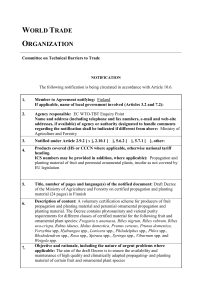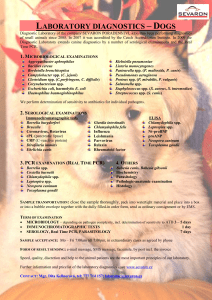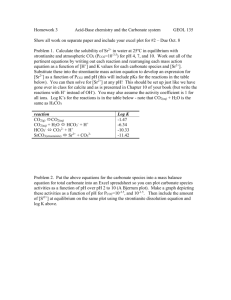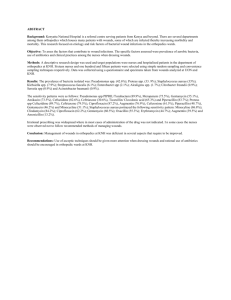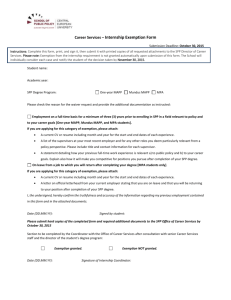R has more than one way of doing MANOVA. Here we
advertisement
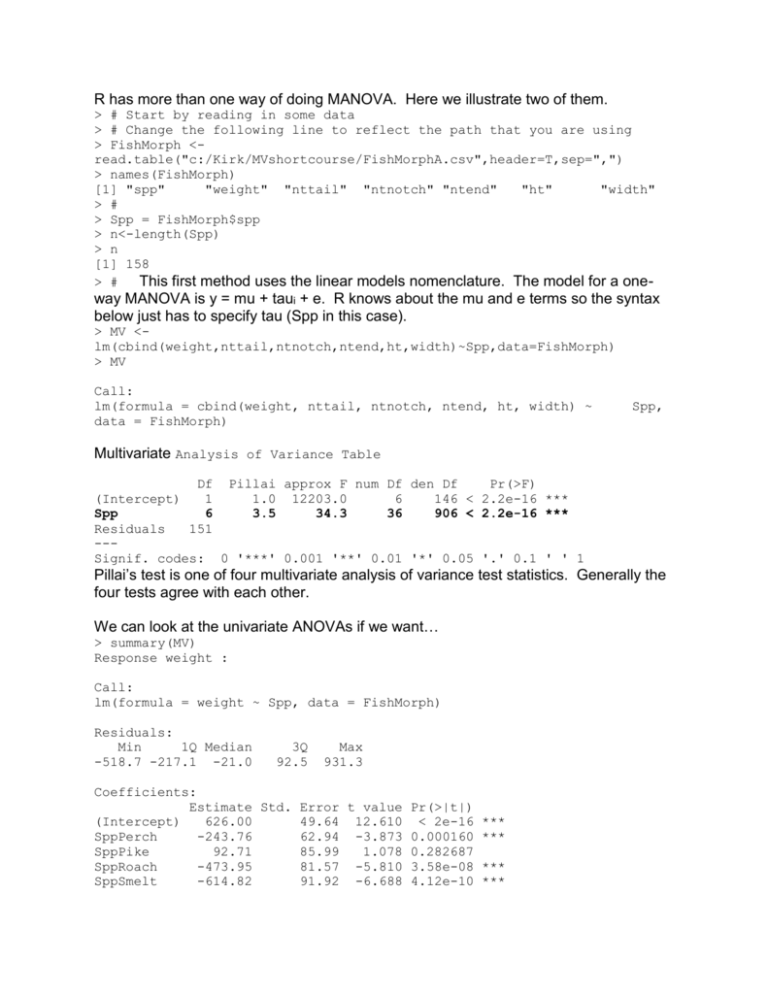
R has more than one way of doing MANOVA. Here we illustrate two of them. > # Start by reading in some data > # Change the following line to reflect the path that you are using > FishMorph <read.table("c:/Kirk/MVshortcourse/FishMorphA.csv",header=T,sep=",") > names(FishMorph) [1] "spp" "weight" "nttail" "ntnotch" "ntend" "ht" "width" > # > Spp = FishMorph$spp > n<-length(Spp) > n [1] 158 > # This first method uses the linear models nomenclature. The model for a one- way MANOVA is y = mu + taui + e. R knows about the mu and e terms so the syntax below just has to specify tau (Spp in this case). > MV <lm(cbind(weight,nttail,ntnotch,ntend,ht,width)~Spp,data=FishMorph) > MV Call: lm(formula = cbind(weight, nttail, ntnotch, ntend, ht, width) ~ data = FishMorph) Spp, Multivariate Analysis of Variance Table Df Pillai approx F num Df den Df Pr(>F) (Intercept) 1 1.0 12203.0 6 146 < 2.2e-16 *** Spp 6 3.5 34.3 36 906 < 2.2e-16 *** Residuals 151 --Signif. codes: 0 '***' 0.001 '**' 0.01 '*' 0.05 '.' 0.1 ' ' 1 Pillai’s test is one of four multivariate analysis of variance test statistics. Generally the four tests agree with each other. We can look at the univariate ANOVAs if we want… > summary(MV) Response weight : Call: lm(formula = weight ~ Spp, data = FishMorph) Residuals: Min 1Q Median -518.7 -217.1 -21.0 3Q 92.5 Max 931.3 Coefficients: Estimate Std. Error t value Pr(>|t|) (Intercept) 626.00 49.64 12.610 < 2e-16 *** SppPerch -243.76 62.94 -3.873 0.000160 *** SppPike 92.71 85.99 1.078 0.282687 SppRoach -473.95 81.57 -5.810 3.58e-08 *** SppSmelt -614.82 91.92 -6.688 4.12e-10 *** SppWhBream SppWhitefsh -471.18 -95.00 100.41 128.18 -4.693 6.00e-06 *** -0.741 0.459759 There are seven species, but only 6 tauhats—the seventh is gotten by subtraction noting that all of the tauhats sum to zero. --Signif. codes: 0 '***' 0.001 '**' 0.01 '*' 0.05 '.' 0.1 ' ' 1 Residual standard error: 289.5 on 151 degrees of freedom Multiple R-Squared: 0.375, Adjusted R-squared: 0.3501 F-statistic: 15.1 on 6 and 151 DF, p-value: 1.694e-13 Etc… Now let’s look at the second approach… The discriminant analysis below requires the “MASS” library. > > library(MASS) > This version of MANOVA uses the “analysis of variance” nomenclature. > MV2 <manova(cbind(weight,nttail,ntnotch,ntend,ht,width)~Spp,data=FishMorph) > MV2 Call: manova(cbind(weight, nttail, ntnotch, ntend, ht, width) ~ Spp, data = FishMorph) Terms: The following summarizes the univariate sums of squares Spp Residuals weight 7591083 12652952 nttail 9493 6285 ntnotch 11056 7076 ntend 13352 7909 ht 10418 388 width 633 184 Deg. of Freedom 6 151 Residual standard error: 289.4726 6.451375 6.845388 7.237116 1.603757 1.104316 Estimated effects may be unbalanced > summary(MV2) Df Pillai approx F num Df den Df Pr(>F) Spp 6 3.460 34.291 36 906 < 2.2e-16 *** Residuals 151 --Signif. codes: 0 '***' 0.001 '**' 0.01 '*' 0.05 '.' 0.1 ' ' 1 Note that the results for the two analyses are the same. I fooled MANOVA into printing out the sums of squares and cross-products matrix for error. Note that the diagonal values are the individual ANOVA error sums of squares. > E <- (n-1)*cov(MV2$residuals) > E weight nttail ntnotch ntend ht width weight 12652952.27 266468.6005 283427.5298 299861.9836 28303.1991 18269.9951 nttail 266468.60 6284.6554 6664.9178 7041.3401 595.0382 377.5523 ntnotch 283427.53 6664.9178 7075.7609 7475.5016 638.5748 405.3956 ntend 299861.98 7041.3401 7475.5016 7908.7532 675.4037 431.7763 ht 28303.20 595.0382 638.5748 675.4037 388.3774 148.0163 width 18270.00 377.5523 405.3956 431.7763 148.0163 184.1465 I also fooled R into printing out the sums of squares and cross-products matrix for species (treatments). Note that the diagonal values are the univariate ANOVA sums of squares for species or treatments. > H <- (n-1)*cov(MV2$fitted.values) > H weight nttail ntnotch ntend ht width weight 7591083.294 251469.8081 273576.9453 306640.7184 62192.7004 -1147.0814 nttail 251469.808 9493.4530 10240.9515 11130.3078 -137.9448 -267.8547 ntnotch 273576.945 10240.9515 11055.9815 12044.8959 125.3972 -239.9840 ntend 306640.718 11130.3078 12044.8959 13352.1863 1330.5677 -279.7009 ht 62192.700 -137.9448 125.3972 1330.5677 10417.9113 1206.9191 width -1147.081 -267.8547 -239.9840 -279.7009 1206.9191 632.8826 The four multivariate test statistics, including Pillai’s test, depend on the eigenvalues of HE-1. > roots<-eigen(H%*%solve(E))$values > roots [1] 5.478328e+01 9.295249e+00 3.736631e+00 1.287332e+00 2.877527e-01 3.015442e-04 R’s MANOVA does not have a convenient function for getting the t-1 = 6 canonical variates associated with the analysis. However, the linear discriminant functions are proportional to the canonical variates. > # > dis<-lda(FishMorph[,-1],Spp,prior = c(1,1,1,1,1,1,1)/7) > dis Call: lda(FishMorph[, -1], Spp, prior = c(1, 1, 1, 1, 1, 1, 1)/7) Coefficients of linear discriminants: CanVar1LD1 CanVar2LD2 Etc. LD3 LD4 LD5 LD6 weight 0.0007552994 0.005407768 -0.006394442 -0.002494222 -0.005972577 -0.003256034 nttail 0.1850420685 1.444298977 -1.537010678 0.587209254 3.054392531 -3.062164748 ntnotch 1.6591660467 0.845843015 3.225632501 1.407882218 -3.414268010 3.032594136 ntend -1.7226673515 -2.377492352 -1.425475748 -1.724661065 0.666842986 -0.108563161 ht -0.6866328962 0.190938581 0.070635366 0.298739353 -0.006109224 -0.027016533 width 0.3554321014 0.242471837 0.534579037 -0.829018685 0.260004147 -0.142753909 The number of interpretable canonical variables is determined by looking at the relative magnitude of the eigenvalues above. It appears that there is one very strong canonical variate and perhaps a second one is interpretable. We would like to calculate the correlations between CanVar1 and CanVar2 with each of the original variables, but I haven’t figured out yet how to do that .




